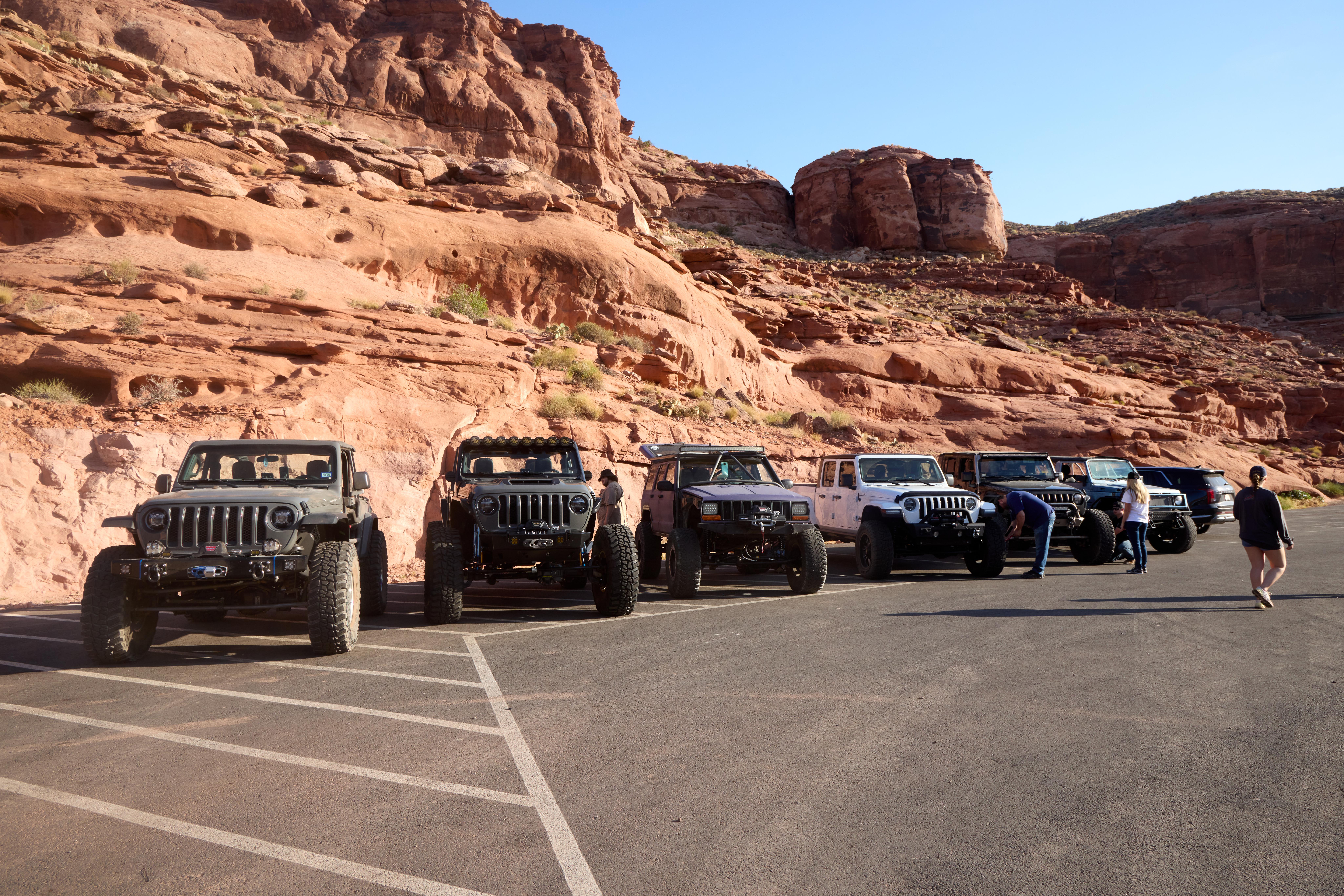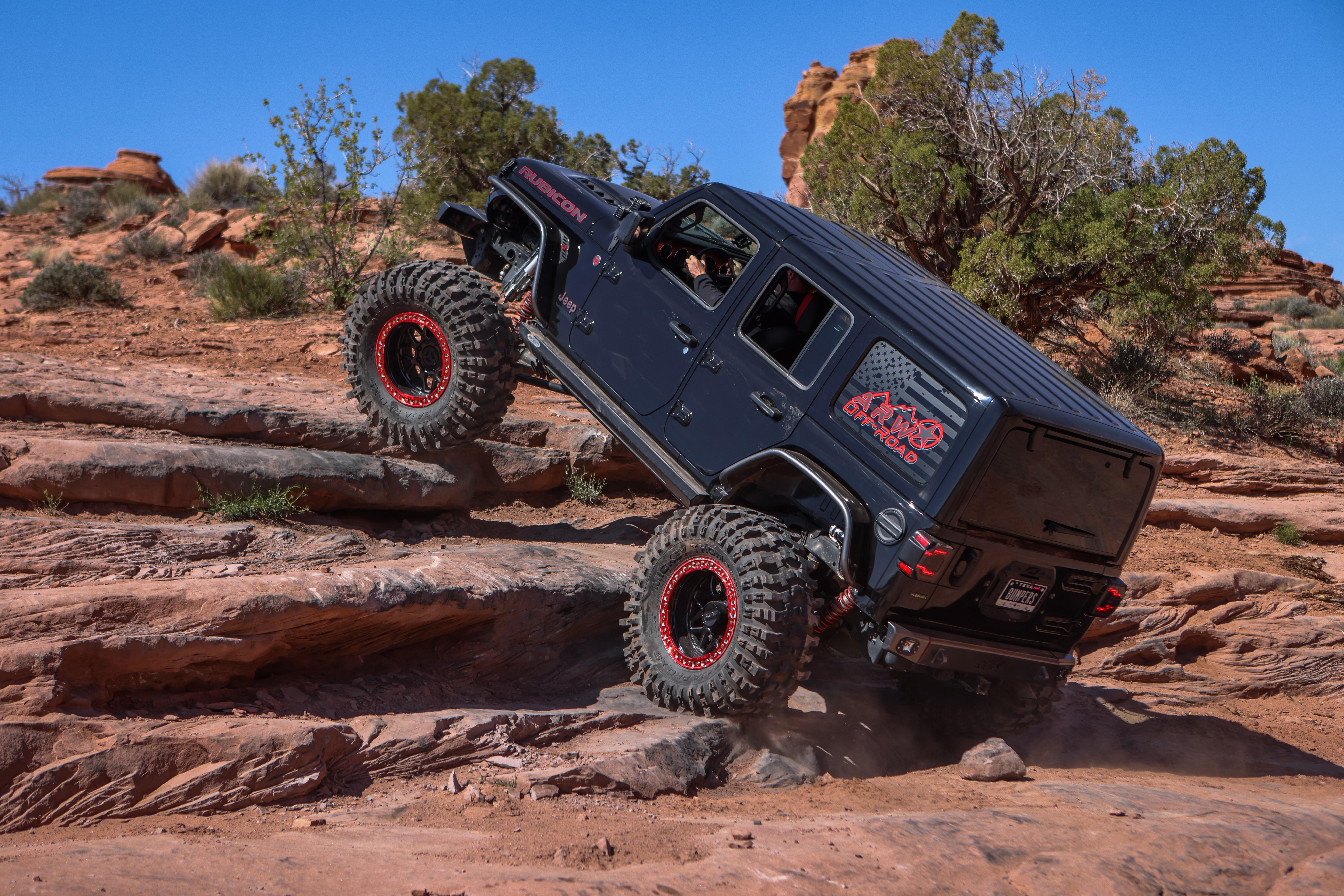Goal of this guide: explain the recovery gear every off-roader should carry, and how to use it safely and effectively. We recommend and trust brands like Warn Winches, Factor 55, and Rugged Radios because they set the benchmark for reliability and safety on the trail.
Why Recovery Gear Matters
Getting stuck is not a matter of if but when. Mud, rocks, sand, or simple bad luck can stop any rig, no matter how well-built. Having proper recovery gear isn’t just about saving your own day — it’s about helping your group, avoiding unnecessary damage, and preventing accidents. A Jeep equipped with a Warn winch and Factor 55 hardware isn’t just capable, it’s prepared.
Every Jeep should carry a baseline kit, with upgrades depending on trail difficulty:
Winch: Rated for at least 1.5× your vehicle’s gross weight (round up, don’t round down). A premium option like the Warn EVO or ZEON series is built to last and trusted worldwide. Maintain the line and keep Warn’s 5 Wrap Rule — at least five wraps on the drum during pulls.
Synthetic vs. Steel: Synthetic rope is safer and lighter, while steel cable is more abrasion resistant. Synthetic is more vulnerable to UV, heat, and abrasion — it should be sleeved or shielded when pulling across rocks. Steel cable is tougher but dangerous when frayed, so gloves are non-negotiable.
Tree Saver Strap: Protects trees when anchoring while spreading load safely.
Shackles / Soft Shackles: Rated recovery points only. Factor 55’s FlatLink, ProLink, or HitchLink make closed-system rigging safe and easy compared to old-school hooks.
Snatch Block / Pulley: Doubles pulling power or allows angled pulls without overstressing the winch. Remember: doubling line pull halves winch speed — don’t confuse slower spooling for weakness.
Recovery Strap / Kinetic Rope: For dynamic pulls using another vehicle. Kinetic ropes store energy, so everyone must stand clear. Only connect to rated recovery points — never a hitch ball, which can shear off and kill.
Gloves & Eye Protection: Winch rope can fray or snap; protect your hands and eyes.
Line Dampener: A heavy blanket, jacket, or purpose-made damper placed over a winch line reduces recoil if something fails. Steel cables store more kinetic energy, but dampers are smart for synthetic lines too.
Radios: Communication is critical. Rugged Radios GMRS systems keep the entire group in sync when spotting or coordinating recoveries.
Gear is only half the equation — knowing how to use it safely is the other.
Assess Before You Pull
Don’t rush into rigging. Stop, walk around, and evaluate anchor points, load paths, and exit routes. Ask: “What happens if this fails?” If the answer involves injury or major damage, rethink the plan. A good habit is following STOPA — Stop, Think, Observe, Plan, Act.
Use Strong Anchors
Anchor to healthy trees near the base, large boulders, or properly rated recovery points. Avoid small saplings or improvised tie-offs that can snap under load. Always use a tree saver to protect anchors and spread the load.
Closed System Rigging
Factor 55 leads the way in closed system winching, replacing open hooks with closed shackles or links. This prevents straps or ropes from slipping free under load, raising both safety and confidence.
Maintain Safety Zones
Everyone not directly involved should stand clear. The danger zone extends in front of and behind a tensioned winch line. A snapped rope or shackle can travel with lethal force. Keep bystanders well to the side — never straddle or step over a live line.
Control the Line
When spooling out rope, disengage the clutch and pull line by hand. Never run the winch motor in reverse to free line unless absolutely necessary. Keep tension smooth and steady when pulling in. Avoid shock loads; jerking a winch line is a recipe for breakage.
Use a Damper
Always place a damper, blanket, or heavy jacket on the line once it’s under tension. This absorbs energy if something lets go, dropping the line safely instead of snapping it across the trail.
Communication Is Key
One person is in charge of the recovery. That person gives the commands, whether by hand signals or radio. Too many voices cause confusion. Always designate a Spotter and make sure everyone knows who that Spotter is. Hand signals should be simple, pre-agreed, and standardized — a clear “stop” and “go” goes a long way. The driver should keep eyes on the Spotter at all times. If visual contact is lost, stop immediately. Rugged Radios headsets or handhelds ensure clarity when distance or noise makes signals harder to see.
Inspect Gear: Check ropes, straps, and shackles for wear or damage before stowing. Retire anything showing cuts, frays, or deformation.
Re-spool the Winch: Run the line in neatly with light tension so it’s ready for the next use. If synthetic rope is wet, dry it before long-term storage.
Pack Organized: Store gear in a dedicated recovery bag or case so it’s accessible when needed.
Winches are designed for controlled tension, not shock loads. Don't tow with it — use the right tool for the job.
Gloves are not optional. Steel or synthetic, winch line can hurt you bare-handed.
Practice at home. Familiarity with your gear means faster, calmer responses on the trail.
Weight ratings matter. Every shackle, strap, and rope must exceed your Jeep’s gross weight.
Never exceed duty cycle. Warn winches are tough, but even they need time to cool between heavy pulls.
Recovery gear is about preparation and respect. The right tools, used correctly, make off-road challenges part of the adventure instead of a dangerous gamble. Equip your Jeep with a complete recovery kit, learn how to use it safely, and always operate with patience and clear communication. At ARW Offroad, we stock and install Warn winches, Factor 55 hardware, and Rugged Radios communication systems — everything you need to wheel with confidence.
The information in Offroad 101 is provided as a general guide for educational purposes. Off-road driving involves inherent risks to vehicles, passengers, and the environment. Even if your Jeep is mechanically capable of handling a trail, your personal experience and driving skill play a critical role in safety and success.
ARW Offroad is not responsible for vehicle damage, injury, or other consequences resulting from the use of this information. We encourage drivers to know their limits, wheel responsibly, and seek hands-on training when tackling advanced terrain.


